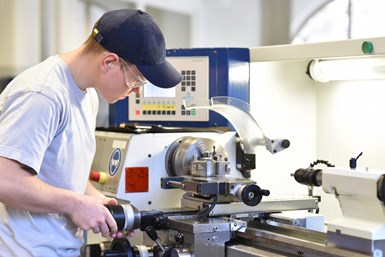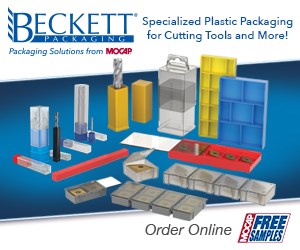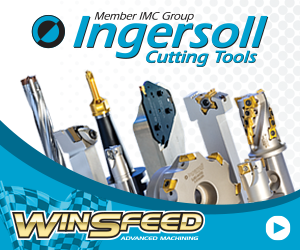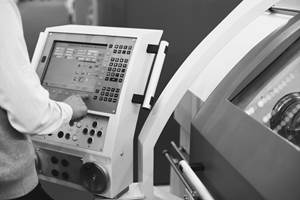6 Ways to Streamline the Setup Process
The primary goal of a setup reduction program must be to keep setup people working at the machine during the entire setup process.
Share




I define setup time as the time that elapses from the completion of the last workpiece in the most recent production run to the first acceptable workpiece in the next production run. Anything that occurs while the machine is down between production runs, regardless of the reason for it, must be considered as part of setup time. And, of course, anything you can do to reduce this time will, in turn, reduce setup time. Getting prepared to make setups is the single most important thing you can do.
As you embark on a setup reduction program, the primary goal must be to keep setup people working at the machine during the entire setup process. If you take the six steps recommend below, there should be no reason for them to leave the machine during setup for any reason.
Most of these suggestions involve gathering items and can be done in preparation for an upcoming setup. If gathering is done up front, gathering time is eliminated from machine downtime between production runs. This, of course, means that you have the people and time required to be gathering while machines are in production.
This also requires adequate documentation that lists and provides the locations for all required components. If components and their locations are documented properly, lesser skilled people can do the gathering. If the setup person is required to gather components, all gathering must be done before they start a setup.
Follow these six steps to streamline the setup process:
Get organized
Setup people must have a good place to work. Keep work benches clean and in order. Logically arrange components needed to make the various setups a machine requires (hand tools, for the most part). Make drawers, cabinets and peg-board storage easily accessible. Avoid sharing often-needed components among machines. If you see a setup person leave the machine during setup to get a needed hand tool, add it to the set of components that will be permanently kept at the machine.
Gather raw material and documentation
While the setup person may not be responsible for bringing raw material to the machine, material must be available to them when they begin a setup. At the very least, bring a few pieces of raw material to the machine before starting the setup. Most companies keep documentation for each job (routing sheet and production information, at least) with the raw material.
Setup people may be required to gather machine- and job-specific documentation for the jobs they run, including setup and production run documentation, quality control documentation, a hard copy of the CNC program and the CNC program itself. Ideally, setup people will load the program for the next job while the current job is running (a feature called background edit allows this). Setup people must also have time to study the documentation and confirm that everything is in order. For example, they should check that they have the current version/revision of the CNC program.
Gather workholding components
Workholding setups vary dramatically among different CNC machines and applications. Sometimes it is possible/feasible to store workholding components near the machines that require them. With lathe work, for instance, it may be good to store all of the top tooling (jaws) in nearby cabinets. In other cases, the size, weight and variety of workholding devices requires a less convenient storage location.
If the setup person is to remain at the machine for the entire setup, the workholding device(s) must be brought to the machine before the setup begins.
Gather cutting tool components
Companies vary with regard to how involved their setup people are with tasks related to cutting tools. While some companies require setup people to gather, assemble and measure cutting tools, many have another person — possibly a tool crib attendant — perform these preliminary tasks. The less a setup person must do, of course, the shorter the period of time the machine will be down between production runs.
Regardless of how much you expect of your setup people in this regard, ensure that they have all of the cutting tool components needed to complete the setup. While you are at it, be sure they have enough perishable cutting tool components (like inserts) to last through the production run.
Gather gaging components
There are many measurements that setup people take with common variable gages, such as calipers, micrometers and depth gauges. Be sure to stock work areas with anything setup people need on a regular basis. However, many setups require special gages — possibly even some that require calibration in order to measure a given workpiece’s particular attributes. Ensure that special gages are gathered — and if necessary, calibrated — before the setup begins. Include any “masters” or “standards” required to check a gage’s calibration.
Schedule first workpiece inspection time
My setup time definition includes running the first good workpiece. While some companies allow the setup person to perform the first workpiece inspection, most require a quality control person to do so, and most companies will not allow the production run to begin until the workpiece passes inspection. For this reason, it is important to ensure that an inspector will be available right after the first workpiece is machined, so be sure to schedule time for first workpiece inspection.
Related Content
Help Operators Understand Sizing Adjustments
Even when CNCs are equipped with automatic post-process gaging systems, there are always a few important adjustments that must be done manually. Don’t take operators understanding these adjustments for granted.
Read MoreStrange But True: Odd Things That Happen With CNCs
These oddities in the way a CNC naturally behaves can help explain some rather unusual situations that may occur during machining.
Read MoreHow to Determine the Currently Active Work Offset Number
Determining the currently active work offset number is practical when the program zero point is changing between workpieces in a production run.
Read More2 Secondary Coordinate Systems You Should Know
Coordinate systems tell a CNC machine where to position the cutting tool during the program’s execution for any purpose that requires the cutting tool to move.
Read MoreRead Next
Setting Up the Building Blocks for a Digital Factory
Woodward Inc. spent over a year developing an API to connect machines to its digital factory. Caron Engineering’s MiConnect has cut most of this process while also granting the shop greater access to machine information.
Read MoreRegistration Now Open for the Precision Machining Technology Show (PMTS) 2025
The precision machining industry’s premier event returns to Cleveland, OH, April 1-3.
Read MoreWhy We Ask Machine Shop Leaders to Speak at TASC – The Automated Shop Conference
TASC is our industry’s premier peer-to-peer automation stage where America’s shop leaders refine the art of metalworking and CNC machining. For conference speakers, it's also an opportunity to showcase your skills and gain exposure for your business. Here are five why stepping into the spotlight at TASC could be your smartest move toward elevating your shop.
Read More
.jpg;width=70;height=70;mode=crop)































